tires AUDI A8 2012 Owners Manual
[x] Cancel search | Manufacturer: AUDI, Model Year: 2012, Model line: A8, Model: AUDI A8 2012Pages: 300, PDF Size: 75.06 MB
Page 5 of 300
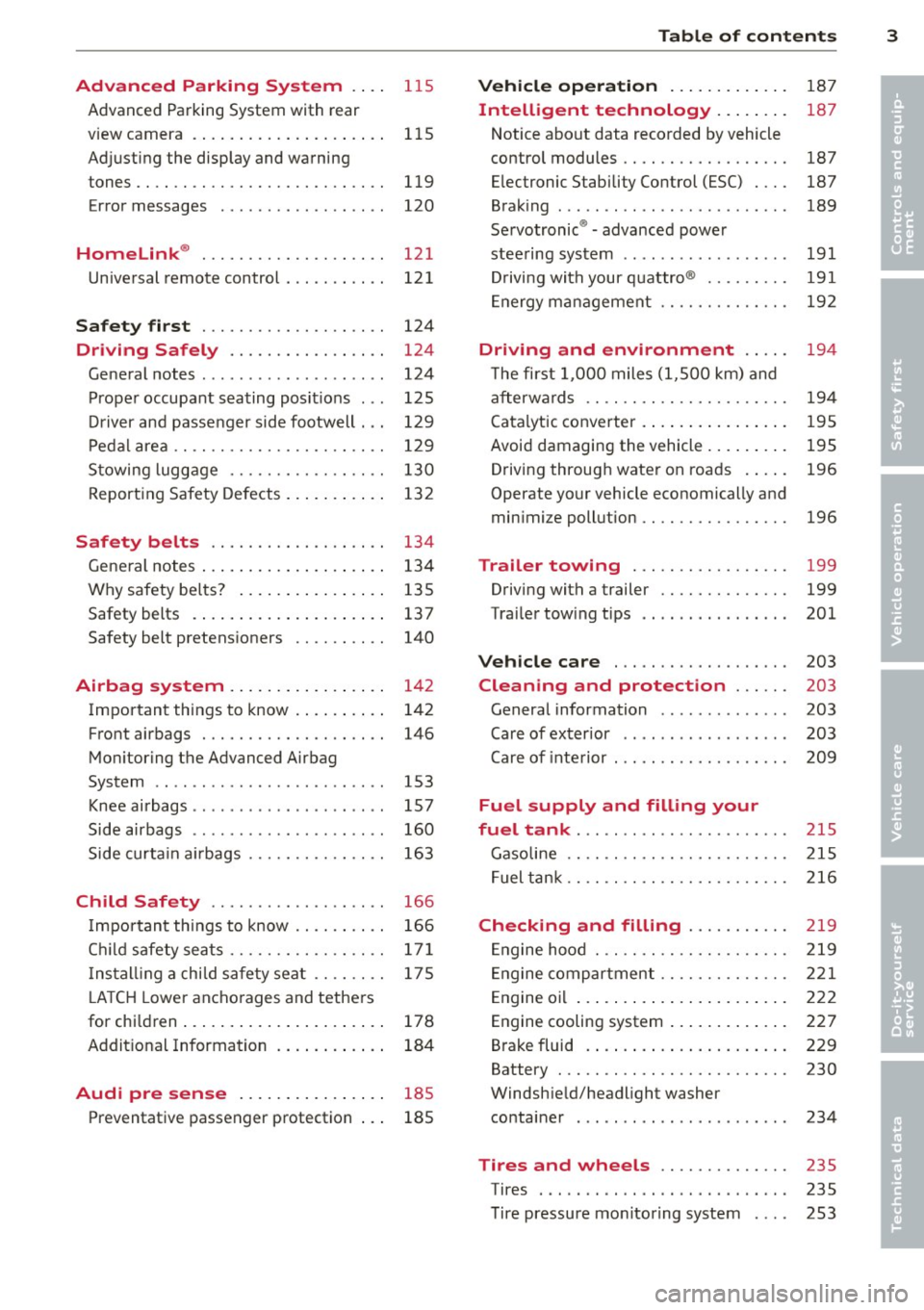
Advanced Parking System . . . . 115
Advanc ed Pa rking System with r ear
view camera . . . . . . . . . . . . . . . . . . . . . 115
Ad justing the display and warning
tones .... .. ................. .. .. 119
E rro r messages
Homelink ® ............ .... .. . .
Universal remote control . .. .. .. .. . . 120
121
121
Safety first
. . . . . . . . . . . . . . . . . . . . 124
Driving Safely . . . . . . . . . . . . . . . . . 124
General notes . . . . . . . . . . . . . . . . . . . . 124
Prope r occupa nt seating posit ions . . . 125
Driver and passenger side footwell . . . 129
Pedal area . . . . . . . . . . . . . . . . . . . . . . . 129
S towing lugg age . . . . . . . . . . . . . . . . . 130
Report ing Safety Defects . . . . . . . . . . . 132
Safety belt s . . . . . . . . . . . . . . . . . . . 134
General notes . . . . . . . . . . . . . . . . . . . . 134
Why safety be lts? . . . . . . . . . . . . . . . . 135
Safety belts . . . . . . . . . . . . . . . . . . . . . 13 7
Safety belt pretens ioners . . . . . . . . . . 140
Airbag system . . . . . . . . . . . . . . . . . 142
Important th ings to know . . . . . . . . . . 142
Front airbags . . . . . . . . . . . . . . . . . . . . 146
Mon itoring the Advanced Airbag
System . . . . . . . . . . . . . . . . . . . . . . . . . 153
Knee airbags . . . . . . . . . . . . . . . . . . . . . 157
Side airbags . . . . . . . . . . . . . . . . . . . . . 160
S ide curta in a irbags . . . . . . . . . . . . . . . 163
Ch ild Safety . . . . . . . . . . . . . . . . . . . 166
I mportant th ings to know .. .. .. .. . .
C hil d safety sea ts ......... .... .. . .
I ns tall ing a chi ld safe ty seat .. .. .. . .
L A T C H L ower ancho rages and tethers
for chi ldren ..... .. .... ... .. .. .. . .
Addit io n al Information
Audi pre sense ..... ... .. .. .. . .
Preventative passenger protection .. . 166
17
1
175
178
184
185
185
Table of contents 3
Vehicle oper ation . . . . . . . . . . . . .
187
Intelligent technology . . . . . . . . 187
Notice about data recorded by vehicle
control modules . . . . . . . . . . . . . . . . . . 187
E lectronic Stability Control (ESC) . . . . 187
B rak ing ...... ... .. ............. .
Se rvotronic ® - advanced powe r
stee ring system ......... ........ .
D rivi ng with your q uattro ® ...... .. . 189
191
191
E nergy m anagement . . . . . . . . . . . . . . 192
Driving and environment . . . . . 194
T he first 1,000 miles (1,500 km) and
a ft erwards . . . . . . . . . . . . . . . . . . . . . . 19 4
Catalytic conve rter. .. ... ...... ... . 195
Avoid damaging the vehicle . . . . . . . . . 195
Driving throug h wate r on roads . . . . . 196
Operate your vehicle economically and
min imize pollution . . . . . . . . . . . . . . . . 196
Trailer towing . . . . . . . . . . . . . . . . . 199
Driv ing with a traile r . . . . . . . . . . . . . . 199
Trai le r tow ing tips . . . . . . . . . . . . . . . . 201
Vehicle care . . . . . . . . . . . . . . . . . . . 203
Cleaning and protection . . . . . . 203
General information . . . . . . . . . . . . . . 203
Care of exterior . . . . . . . . . . . . . . . . . . 203
Car e of inte rior . . . . . . . . . . . . . . . . . . . 209
Fuel supply and filling your
fuel tank ... .. .... .......... ....
215
Gasoline . . . . . . . . . . . . . . . . . . . . . . . . 215
F uel tank.. .. .. .. ... ............ . 216
Checking and filling . . . . . . . . . . . 219
E ngine hood . . . . . . . . . . . . . . . . . . . . . 219
Engine compartmen t . . . . . . . . . . . . . . 221
E ngine oil . . . . . . . . . . . . . . . . . . . . . . . 222
Engine cooling system . . . . . . . . . . . . . 227
Brake fluid . . . . . . . . . . . . . . . . . . . . . . 229
Battery . . . . . . . . . . . . . . . . . . . . . . . . . 230
Windsh ie ld/headlight washer
container . . . . . . . . . . . . . . . . . . . . . . . 234
Tires and wheels . . . . . . . . . . . . . . 235
Tires . . . . . . . . . . . . . . . . . . . . . . . . . . . 235
T ire pressure mo nitoring system . . . . 253
•
•
Page 29 of 300
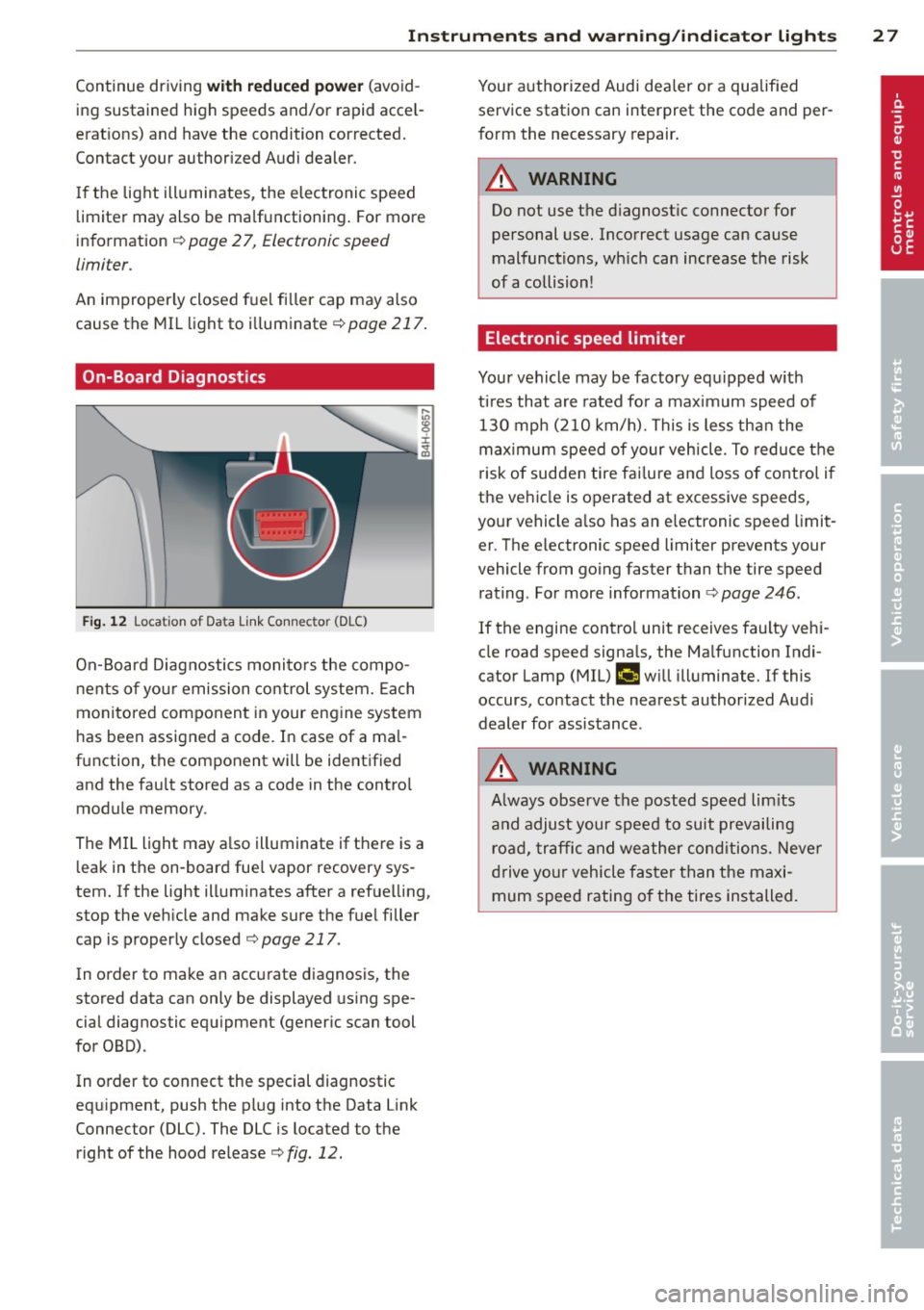
Instruments and warning/indicator lights 2 7
Continue driving with reduced power (avoid
ing sustained high speeds and/or rapid accel
erat ions) and have the condition corrected.
Contact your author iz ed Audi dealer.
If the light ill uminates, the electronic speed
limiter may also be ma lfunctioning . For more
information ¢
page 2 7, Electronic speed
limiter .
An improperly closed fuel fi ller cap may also
cause the MIL light to ill uminate ¢
page 217.
On-Board Diagnostics
Fig. 12 Loca tion of Data Li nk Connector (DLC)
On-Board Diagnostics monitors the compo
nents of yo ur emission control system. Each
mon itored component in your engine system
has been assigned a code. In case of a ma l
function, the component will be identified and the fault stored as a code in the contro l
module memory.
The MIL light may a lso illuminate if there is a
l eak in the on-board fue l vapor recovery sys
tem. If the light illuminates after a ref uelling,
stop the veh icle and make sure the fue l filler
cap is properly closed ¢
page 217.
In order to make an accurate diagnosis, the
stored data can only be displayed using spe
cial diagnostic equipment (gener ic scan tool
for OBD).
In order to connect the special diagnostic
eq uipment, push the plug into the Data Link
Connector (DLC). The DLC is located to the right of the hood release¢
fig. 12.
Your authorized Audi dea ler or a qualified
service station can interpret the code and per
form the necessary repair.
A WARNING
Do not use the diagnostic connector for
personal use. Incorrect usage can cause
malfunctions, wh ich can increase the risk
of a collision!
Electronic speed limiter
-
Your vehicle may be factory equipped w ith
t ir es that are rated fo r a maximum speed of
130 mph (210 km/h). This is less than the
maximum speed of your vehicle . To reduce the
risk of sudden tire fai lure and loss of control if
the vehicle is operated at excessive speeds,
your vehicle a lso has an e lectronic speed limit
er . The e lectronic speed limiter prevents your
vehicle from going faster than the tire speed rating . For more information ¢
page 246.
If the engine contro l unit receives faulty vehi
cle road speed signa ls, the Ma lfunction Indi·
cator Lamp (MIL)
fllllij w ill illuminate. If this
occurs, contact the nearest authorized Audi
dealer for assistance .
A WARNING
-
Always observe the posted speed limits
and adjust your speed to suit prevailing road, traffic and weather conditions. Never
drive your vehicle faster than the maxi
mum speed rating of the tires installed.
Page 86 of 300
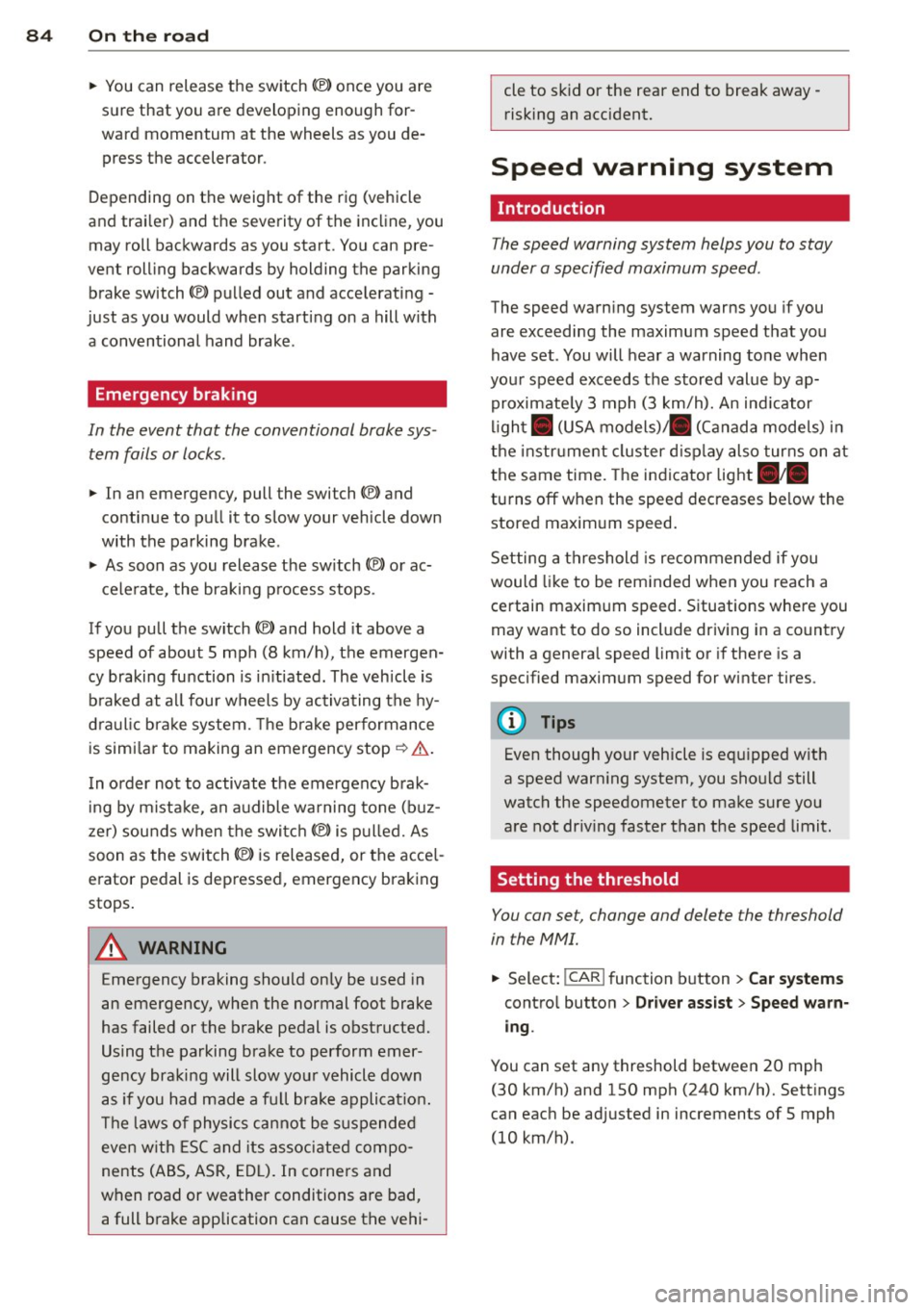
84 On th e road
• You can release the switch (®) once you are
sure that you are developing enough for
ward momentum at the wheels as you de
press the accelerator .
Depending on the weight of the rig (vehicle
and trai ler) and the severity of the incline, you
may roll backwards as you start . You can pre
vent roll ing backwards by holding the parking
brake switch(®) pulled out and accelerating -
just as you would when starting on a hill with
a conventional hand brake .
Emergency braking
In the event that the conventional brake sys
tem fails or locks .
• In an emergency, pull the switch(®) and
continue to pull it to slow your vehicle down
with the parking brake .
• As soon as you release the sw itch
C®> or ac-
cele rate , the braking p rocess stops.
If you pull the switch(®) and hold it above a
speed of about 5 mph (8 km/h), the emergen
cy braking function is in it iated. The veh icle is
b raked at all four wheels by activa ting the hy
d raul ic br ake system. The b rake performance
is simi lar to making an emergency stop
c::> & .
In order not to activate the emergency brak
i ng by m ista ke, an audible wa rning tone (bu z
z er) sounds when the swi tc h
C®> is pulled. As
soon as the switch(®) is released, or the accel
erator pedal is depressed, emergency braking
stops .
.&_ WARNING
Emergency braking should only be used in
an emergency, when the normal foot brake
has failed or the brake pedal is obstructed.
Using the parking bra ke to perform emer
gency braking will slow yo ur vehicle down
as if you had made a fu ll brake applicat ion.
T he laws of physics cannot be s uspended
even w ith ESC and its associate d compo
nents (ABS, ASR, EDL). In corners and
when road or weather conditions are bad, a full brake application can cause the vehi- cle to sk
id or the rear end to break away -
risking an accident.
Speed warning system
, Introduction
The speed warning system helps you to stay
under a specified maximum speed .
The speed warning system warns you if you
are exceeding the maximum speed that you
have set . You will hear a warning tone when
your speed exceeds the stored value by ap proximate ly 3 mph (3 km/h). An ind icator
l ight . (USA
models) ;a (Canada mode ls) in
the instr ument cluster d isp lay also tur ns on at
the same time. The indicator light.,.
turns off when the speed decreases be low the
stored maxim um speed.
Setting a th reshold is recommended if you
would like to be rem inded when you reach a
certain maxim um speed. Situations whe re you
may want to do so include driving in a co untry
with a genera l speed limit or if there is a
specified maximum speed for winter tires.
(D Tips
Even though your vehicle is equipped w ith
a speed warn ing system, you should still
watch the speedometer to make sure you
are not dr iv ing faster than the speed limit.
Setting the threshold
You can set, change and delete the threshold
in the MMI.
• Select: !CAR ! function b utton > Car systems
contro l button > Dri ver ass ist > Speed warn
ing .
You can set any threshold between 20 mph
(30 km/h) and 150 mph (240 km/h). Sett ings
can each be adj usted in increments of 5 mph
(10 km/h).
Page 106 of 300

104 Audi dri ve sele ct
surface o f the tires, which is the outer
circumference. Securing the vehicle at
the axle components, s uspension struts
or towing eyes is not perm itted because
the pressure in the air suspension struts
can change during transport. The veh icle
may not be secured suff ic iently if this
happens .
- If you are go ing to tow a trailer, you
must activate the trailer operat ion mode
¢page 199.
@ Tips
- In some models, the maximum vehicle
speed can only be reached in the
auto
and dynamic modes.
- Selecting the
dynamic mode results in
spo rty sh ifting character istics. The S
gear position engages automati cally.
- In vehicles that have dynamic steering*,
operating noise is heard when starting or
stopp ing the eng ine . Th is does not ind i
cate a problem.
- In vehicles with sport differential*, the
dynam ic mode is deactivated whe n tow
i ng a traile r.
Selecting the driving mode
You can choose be tween Comfort, Auto, Dy
namic and Individual.
Fi g. 106 MM!: D rive se lect
.,. To se lect the mode, select the following in
the MMI :
I CARI function button> Comfort ,
Auto , Dynamic or Indi vidu al.
You can change the driving mode when the ve
hicle is stationary or while driving . If traffic
permits, after changing modes, briefly take
your foot off the accelerator pedal so that the
recently selected mode is also activated for
the engine.
comfort -provides a comfort-oriented vehicle
setup and is suited for long drives on high
ways.
auto -provides an overall comfortable yet dy
nam ic driving feel and is suited for every day
use.
d yna mi c -gives the vehicle a sporty driving
feel and is suited to a sporty driving style .
individual -¢ page 105.
A WARNING
Pay attention to traffic when operating Au
d i drive select to prevent potential risk of
an accide .nt.
Page 133 of 300

-Always distribute the load as evenly as
possible.
- Place heavy objects as far forward in
the luggage compartment as possible.
- Never exceed the Gross Axle Weight Rat
ing or the Gross Vehicle Weight Rating
specified on the safety compliance stick
er on the left door jamb. Exceeding per
missible weight standards can cause the
vehicle to slide and handle differently .
- Please observe information on safe driv
ing
o page 124 .
A WARNING
-
To help prevent poisonous exhaust gas
from being drawn into the vehicle, always
keep the rear lid closed while driving .
- Never transport objects larger than those fitting completely into the luggage
area because the rear lid cannot be fully
closed.
- If you absolutely must drive with the rear
lid open, observe the following notes to
reduce the risk of poisoning:
-Close all windows,
- Close the power roof,
- Open all air outlets in the instrument
panel,
- Switch off the air recirculation,
- Set the fresh air fan to the highest
speed.
A WARNING
Always make sure that the doors, all win dows, the power roof and the rear lid are
securely closed and locked to reduce the
risk of injury when the vehicle is not being
used .
- After closing the rear lid, always make
sure that it is properly closed and locked.
- Never leave your vehicle unattended es pecially with the rear lid left open. A
child could crawl into the vehicle through
the luggage compartment and close the
rear lid becoming trapped and unable to
get out . Being trapped in a vehicle can
lead to serious personal injury .
-
Driving Safely 131
-Never let children play in or around the
vehicle.
- Never let passengers ride in the luggage
compartment. Vehicle occupants must
always be properly restrained in one of
the vehicle's seating positions .
(D Tips
-Air circulation helps to reduce window
fogging. Stale air escapes to the outside
through vents in the trim panel, on the
left side of the luggage compartment. Be sure to keep these slots free and
open .
- The tire pressure must correspond to the
load . The tire pressure is shown on the
tire pressure label. The tire pressure la
bel is located on the driver's side B-pillar.
The tire pressure label lists the recom
mended cold tire inflation pressures for
the vehicle at its maximum capacity
weight and the tires that were on your
vehicle at the time it was manufactured.
For recommended tire pressures for nor
mal load conditions, please see chapter
opage 239.
Tie-downs
The luggage compartmen t is equipped with
four tie-downs to secure luggage and o ther
items .
Use the tie-downs to secure your cargo prop
erly
o page 130, Loading the luggage com
partment .
In a collision , the laws of physics mean that
even smaller items that are loose in the vehi
cle will become heavy missiles that can cause
serious injury. Items in the vehicle posses s en
ergy which vary with vehicle speed and the
weight of the item. Vehicle speed is the most
significant factor.
For example, in a frontal collision at a speed
of 30 mph (48 km/h), the forces acting on a
10-lb (4 .5 kg) object are about 20 times the
normal weight of the item . This means that
the weight of the item would suddenly be
•
•
Page 193 of 300
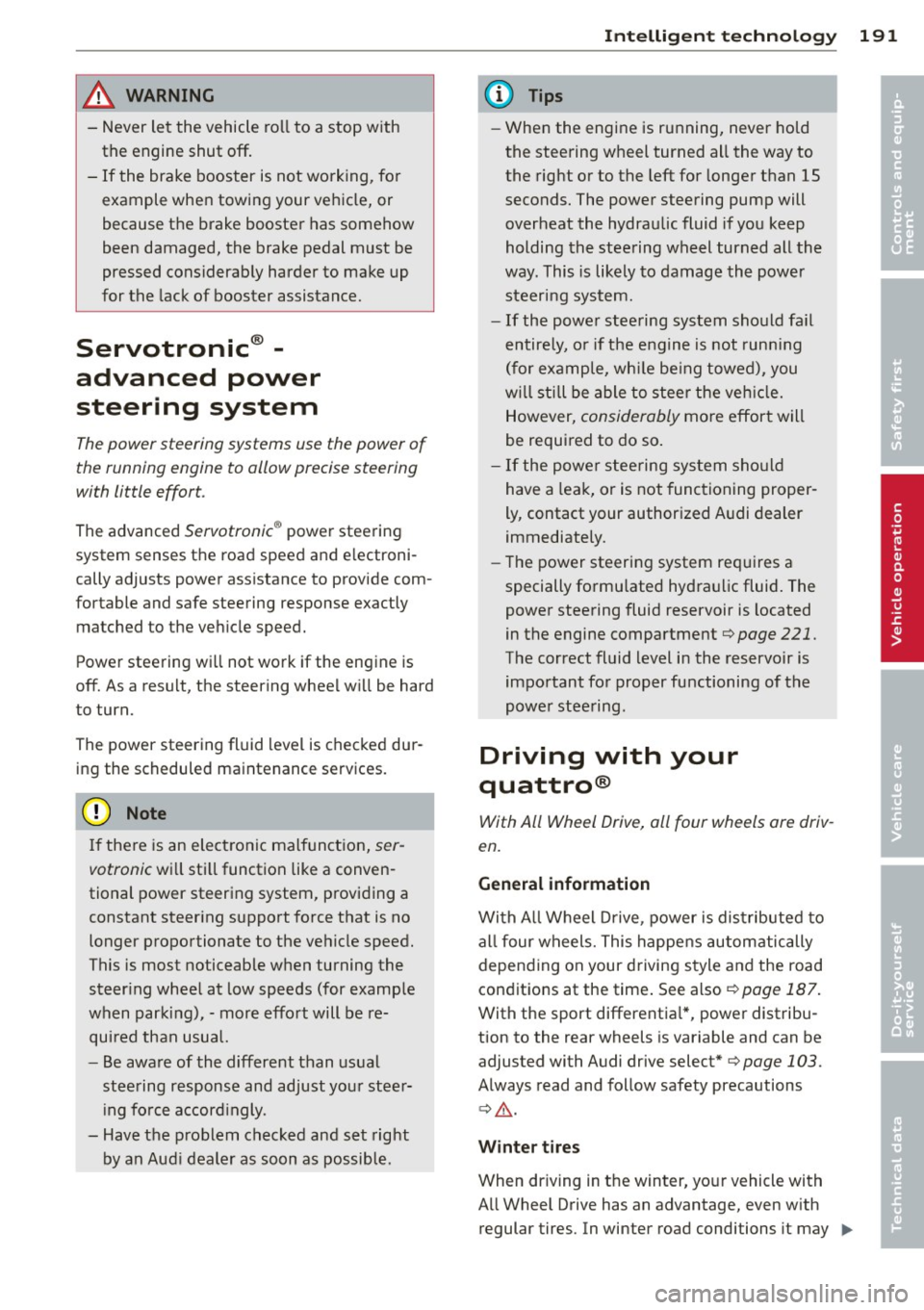
& WARNING
-Never let the vehicle roll to a stop with
the engine shut
off.
- If the brake booster is not working, for
example when towing your vehicle, or
because the brake booster has somehow
been damaged, the brake pedal must be
pressed considerably harder to make up
for the lack of booster assistance.
Servotronic ® -
advanced power
steering system
-
The power steering systems use the power of
the running engine to allow precise steering
with little effort.
The advanced Servotronic ® power steering
system senses the road speed and e lectroni
cally adjusts power ass istance to provide com
fortable and safe steering response exactly matched to the veh icle speed.
Power steering wi ll not work if the engine is
off. As a resu lt, the steering whee l wi ll be hard
to turn.
The power steering fluid level is checked dur ing the scheduled maintenance services.
(D Note
I f there is an electronic malfunct ion, ser
votronic
will sti ll function like a conven
tional power steering system, providing a
constant steering support force that is no
longer proportionate to the vehicle speed.
This is most noticeable when turning the steer ing whee l at low speeds (for examp le
when parking), -more effo rt will be re
qui red than usual.
- Be awa re of the different than usual
steering response and adjust your stee r
i ng fo rce accord ingly.
- Have the p roblem checked and set right
by an Aud i dealer as soon as possib le .
Int ellig ent technolog y 191
(D Tips
-When the engine is running, never ho ld
the steering wheel turned all the way to
the right or to the left for longer than 15
seconds. The power steering pump will
overheat the hydrau lic fluid if you keep
holding the stee ring wheel turned all the
way. This is likely to damage the power
steering system.
- If the powe r stee ring system should fa il
entire ly, o r if the e ngine is not run ning
(for example, wh ile be ing towed), you
w ill still be able to stee r the veh icle.
However,
considerably more effor t will
be required to do so .
- If the power stee ring system sho uld
have a lea k, or is not functioning proper
ly, contact your authorized A udi dealer
immediately.
- The power steering system req uires a
specially formu lated hydra ulic fluid. The
power steering fluid reservoir is located
in the engine compartment
Q page 221.
The correct fluid level in the reservoir is
important for proper functioning of the
powe r stee ring.
Driving with your
quattro ®
With All Wheel Drive, all four wheels ore driv
en.
General information
Wi th A ll Wheel Drive, power is dis tributed to
all four w heels. This happens automatically
depend ing on your driving style and the road
conditions at the time . See a lso
Q page 187.
With the sport different ia l*, power distribu
tion to the rear wheels is variable and can be
adjusted with Audi drive select*
Qpage 103.
Always read and follow safety precautions
Q&_ ,
Winter tires
When dr iving in the winter, yo ur vehicle with
A ll Wheel Drive has an advantage, even w ith
regular tires. In winter road conditions it may ..,. •
•
Page 194 of 300

192 Intelligent technology
be advisable to mount winter tires (or all-sea
son ti res) for improved driveability and brak
ing: these t ires must be mounted on
all four
w heels .
See also c> page 250, Winter tires.
Snow chains
Where snow cha ins are mandatory on certa in
roads, this normally a lso applies to vehicles
with A ll Wheel Driver=:>
page 251, Snow
chains.
Replacing wheels /t ire s
Vehicles w it h All Wheel Dr ive must always
have tires of the same size . Also avoid tires
with different tread depths. For details see
page
c> page 246, New tires and replacing
tires and wheels.
Off-Road driv ing?
Your Audi does not have enough ground clear
ance to be used as an off -road vehicle.
It is
therefore best to avoid rough tracks and un
even terrain as much as possible. Also refe r to
i=>page 195.
A WARNING
Always adjust your driving to road and traf
fic condit ions. Do not let the extra safety
afforded by All Whee l Drive tempt you into
taking extra risks.
-Although the All Whee l Drive is very ef
fective, a lways remember that b raking
capacity is limited by t ire traction. You
should the refore not dr ive at excessive
speeds on icy or slippery road su rf a ces.
- On wet road su rfaces, be careful not to
dr ive t oo fast becau se t he front wheels
co uld beg in to s lide on top of the wa ter
(aquaplaning) .
If this should occ ur, you
wi ll have no warning from a sudden in
crease in engine speed as with a front
wheel drive vehicle. A lways drive at
speeds wh ic h are suited to the road con
ditions -risk of crash.
Energy management
Starting ability is optimized
Energy management controls the distribution
of electrical energy and thus optimizes the
availability of electrical energy for starting the engine.
If a vehicle with a conventiona l energy system
is not driven for a long per iod of t ime, t he bat
te ry is discharged by idling current consume rs
(e.g. immobili ze r). In certa in circumstan ces it
ca n res ult in the re be ing insufficien t energy
available to start the eng ine.
Intelligent energy management in your vehi
cl e ha ndles the dist rib ution o f electr ica l ene r
gy. Start ing abili ty is m arkedly improved and
the life of the battery is extended .
Bas ica lly, energy management consists of
batt ery diagnosis , idling current manage
ment
and dynamic energy management .
Battery diagnosis
Battery diagnosis continuously determines
the state of the batte ry. Sensors determine
batte ry voltage, battery cu rr e nt and battery
tempe ratu re. This de termines the cur ren t
state o f cha rge and t he power o f th e battery.
Idling current management
Idli ng current management reduces energy
consumpt ion while the vehicle is standing.
With the ig nition sw itched off, it controls the
energy supp ly to the variou s ele ctri ca l compo
nen ts. Da ta from ba ttery d iagnos is is co nsid
ered.
Depend ing on the batte ry's state of cha rge,
i ndivid ual con sume rs a re g radually turned off
to prevent excessive discharge o f the battery
and th us main tain starting capabi lity.
Dynamic energy management
While the vehicle is being d riven, dynamic en
ergy ma nagement distr ib utes the energy ge n
era ted a ccord ing to t he needs of the individ u-
al components.
It r egula tes consumption, so
t h at more e lectrical energy is not being used ..,.
Page 196 of 300
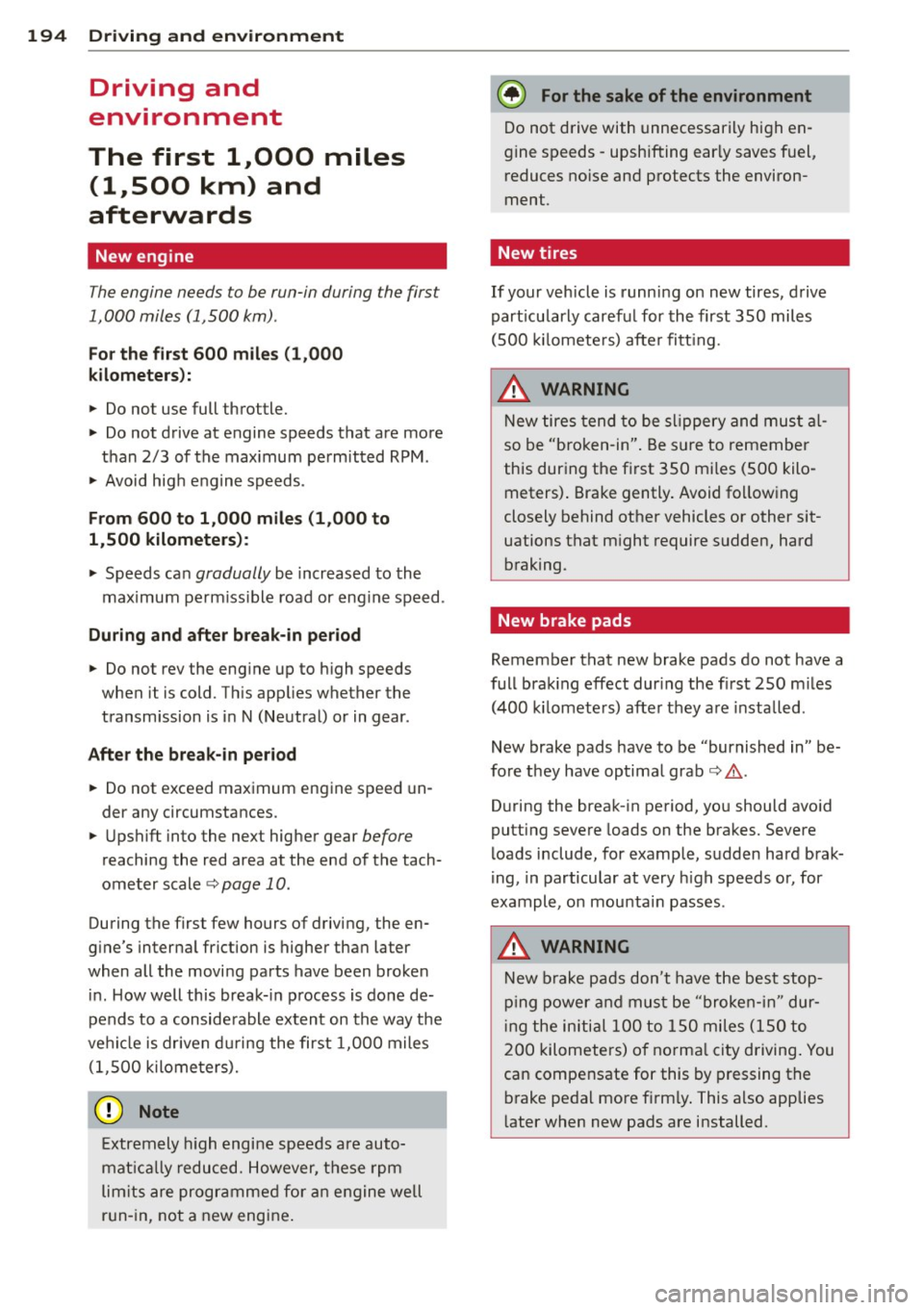
194 Driving and environment
Driving and
environment
The first 1,000 miles
(1,500 km) and
afterwards
New engine
The engine needs to be run-in during the first
1,000 miles (1,500 km).
For the fir st 600 miles (1,000
kilometers ):
.,. Do not use full throttle.
... Do not drive at engine speeds that are more
than 2/3 of the max imum permitted RPM.
... Avoid hig h engine speeds.
From 600 to 1,000 mile s (1 ,000 to
1,500 kilometers):
... Speeds can gradually be increased to the
max imum pe rm iss ible road or eng ine speed .
During and after break-in per iod
.,. Do not rev the engine up to high speeds
when it is cold. Th is app lies whether the
transm ission is i n N (Neutra l) or in gear.
After the break-in period
... Do not exceed maximum engine speed un
der any circumstances.
.,. Upshift into the next hig her gear
before
reaching the red area at the end of the tach
ometer scale
c:> page 10.
During the first few hours of driving, the en
g ine's interna l friction is higher than later
when all the moving parts have been broken
in . How well this break- in p rocess is do ne de
pends to a conside rable extent on th e way the
ve hicl e is driven d uring the first 1,0 00 miles
(1, 500 k ilome ters).
0 Note
E xtremely high engi ne speeds are auto
mat ica lly reduced. However, these rpm
lim its are progr amme d for an engine well
r u n- in, not a new engine .
{® For the sake of the environment
Do not drive with unnecessarily high en
g ine speeds - upshifting ear ly saves fuel,
reduces no ise and protects the environ
ment.
, New tires
If your vehicle is runni ng on new tires, drive
part icularly caref ul for the first 350 miles
(500 kilomete rs) afte r fitt ing .
A WARNING
New tires tend to be sl ippery and mus t al
so be "broken -in" . Be s ure to remember
this dur ing the fi rst 350 mi les ( 500 kilo
meters) . Brake gently . Avoid fo llow ing
closely behind other vehicles or other sit
uations that m ight require sudden, hard
braking .
New brake pads
Remember that new brake pads do not have a
full bra king effect dur ing the fi rst 250 m iles
(400 kilomete rs) afte r they a re insta lled .
New brake pads have to be "burnished in" be
fo re t hey have optima l grab
c:> A .
During the break- in period, you should avoid
putting severe loads on the brakes. Severe
l oads include, for example, sudden hard brak
i ng, in particular at very high speeds or, for
example, on mounta in passes .
A WARNING
New b rake pa ds don't have t he bes t stop
pi ng power and mus t be "broke n-in " dur
i ng the in iti al 1 00 to 150 mi les (150 to
20 0 k ilometers) of no rma l city driving . You
can compensate for this by pressing the
br ake peda l mo re f irm ly . This also applies
l ater when new pads are installed.
Page 198 of 300
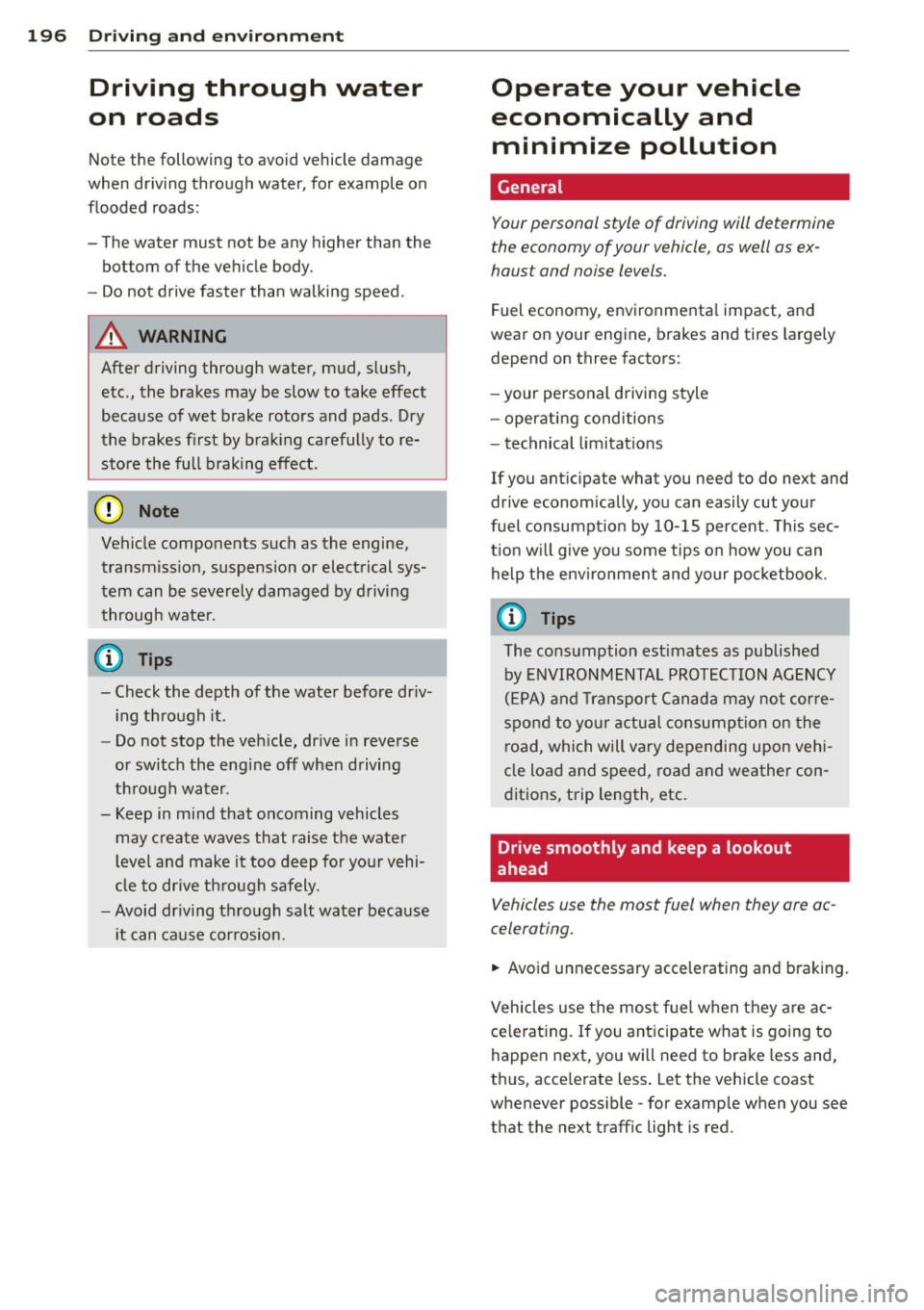
196 Driving and en vironm ent
Driving through water
on roads
Note the following to avoid vehicle damage
when driving through water, for example on
flooded roads:
- The water must not be any higher than the
bottom of the vehicle body.
- Do not drive faster than wa lking speed.
A WARNING
After driving through water, mud, slush,
etc., the brakes may be slow to take effect
because of wet brake rotors and pads. Dry
the brakes first by braking carefully to re
sto re the full braking effect.
@) Note
Vehicle components such as the engine,
transmiss ion, suspension or electrical sys
tem can be severely damaged by driving
through water.
- Check the depth of the water before dr iv
i ng through it.
- Do not stop the vehicle, drive in reverse
or switch the engine off when driving
through water .
- Keep in mind that oncoming vehicles
may create waves that raise the water
level and make it too deep for your vehi
cle to drive through safely.
- Avoid dr iving through salt water because
i t can cause corrosion.
Operate your vehicle
economically and
minimize pollution
General
Your personal style of driving will determine
the economy of your vehicle, as well as ex
haust and noise levels.
Fuel economy, environmenta l impact, and
wear on your engine, brakes and tires largely
depend on three factors:
- your personal driving style
- operating conditions
- technical limitations
If you anticipate what you need to do next and
drive economically, you can easily cut your
fuel consumpt ion by 10-15 percent . This sec
t ion will give you some tips on how you can
help the env ironment and your pocketbook.
@ Tips
The consumption estimates as published
by ENVIRONMENTAL PROTECTION AGENCY
(EPA) and Transport Canada may not corre
spond to your actual consumption on the
road, which will vary depending upon vehi
cle load and speed, road and weather con
ditions, trip length, etc.
Drive smoothly and keep a lookout
ahead
Vehicles use the most fuel when they are ac
celerating.
.,. Avoid unnecessary accelerating and braking.
Vehicles use the most fuel when they are ac
ce lerating. If you anticipate what is going to
happen next, you will need to brake less and,
thus, acce lerate less . Let the vehicle coast
whenever possible - for example when you see
that the next traffic light is red.
Page 202 of 300
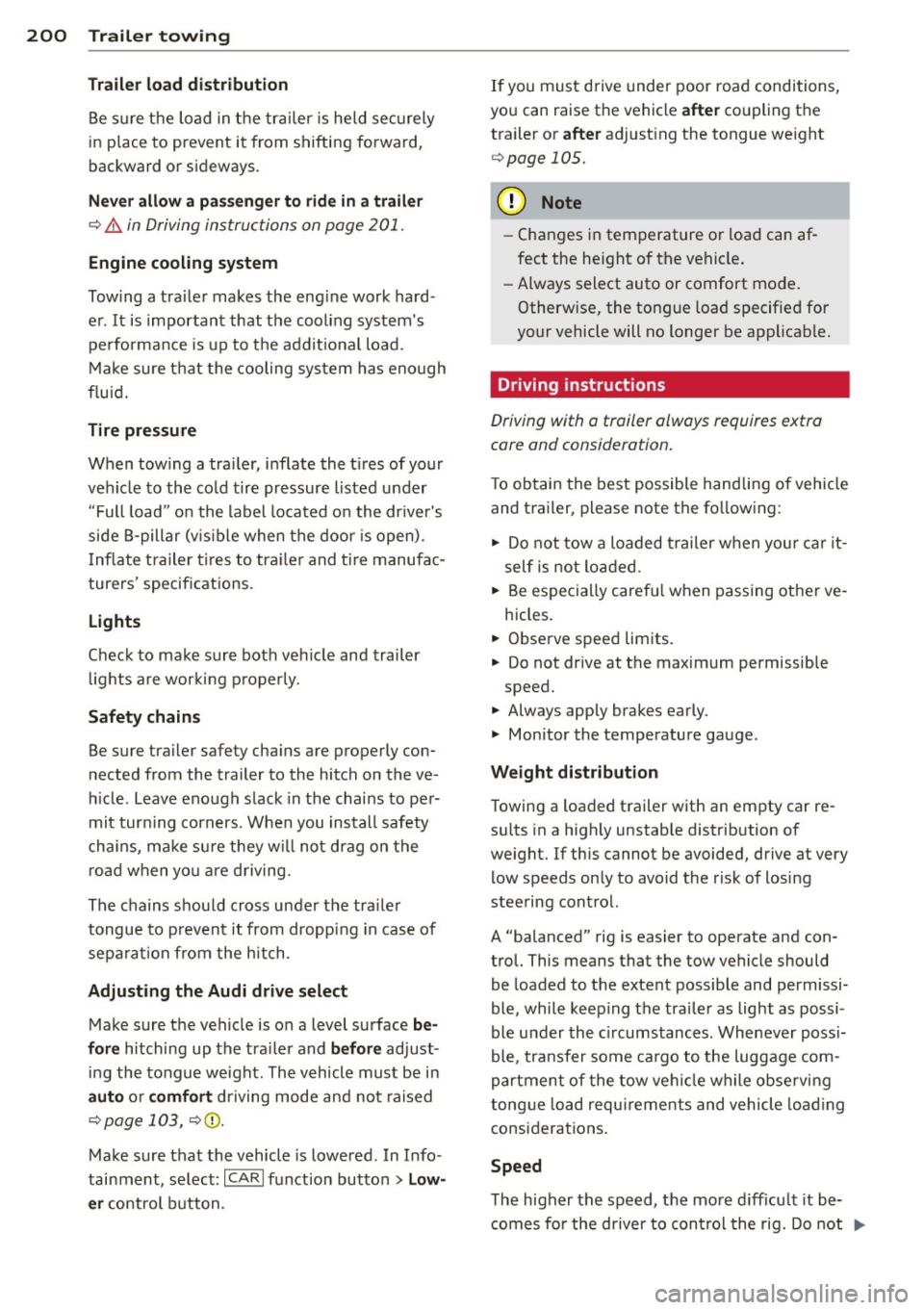
200 Trailer towing
Trail er load dis tr ibut ion
Be sure the load in the trai ler is held securely
in place to prevent it from shifting forward,
backward or sideways.
N eve r all ow a p assenger to rid e in a trailer
~ .&. in Driving instructions on page 201.
Engine cooling sy stem
Towing a tra iler makes the eng ine work hard
er . It is important that the cooling system's
performance is up to the addit ional load .
Make sure that the cooling system has eno ugh
flu id.
Tir e pressure
When tow ing a tra iler, inflate the t ires of your
vehicle to the co ld tire pressure listed under
" Full load" on the label loca ted o n the dr iver's
side B-pillar (v is ible when the door is open).
I nflate trailer tires to tra iler and tire manufac
turers' specifications.
Lights
Check to make sure both veh icle and trailer
l ights are wor king p roperly.
Safe ty chain s
Be sure tra iler safety cha ins are properly con
nected from the trailer to the hitch on the ve
h icle . Leave enough slack in the chains to per
mit turning corners. When you install safety
cha ins, make sure they w ill not drag on the
road when yo u are driving.
The chains shou ld cross under the tra iler
tongue to prevent it from dropping in case of
separat ion from the hitch .
Adjusting the Audi drive select
Make sure the vehicle is on a level surface be
for e
hitching up the tra iler and b efor e adjust
ing the tongue weight . The vehicle must be i n
auto or comfort driving mode and not raised
~ page 103, ~CD .
Make sure that the vehicle is lowered . In Info
tainment, select:
I CARI function button> Lo w
e r
control button . If you must drive under poor road conditions,
you can raise the vehicle
afte r coupling the
trailer or
a fter adjust ing the tongue we ight
~ page 105.
(D Note
-Changes in temperature or load can af
fect the height of the vehicle .
- Always select auto or comfort mode .
Otherwise, the tongue load specified for
your vehicle will no longer be applicable.
Driving instructions
Driving with a trailer always requires extra
core and consideration.
T o obtain the best possible hand ling of vehicle
and trailer, please note the fo llowing:
.. Do not tow a loaded t railer when you r ca r it
self is not loaded .
.. Be especially carefu l when passing other ve
hicles .
.. Observe speed limits.
.. Do not drive at the maximum permissible
speed .
.. Always apply brakes early .
.. Monitor the temperature gauge .
Weight distribut ion
T owing a loaded trailer with an empty car re
s ul ts in a highly unstable distribution of
weight. If this cannot be avoided, drive at very
low speeds only to avoid the risk of losing
steering control.
A "balanced" rig is easier to operate and con
trol. This means that the tow vehicle should
be loaded to the extent possible and permissi
ble , while keep ing the trailer as light as possi
ble under the ci rcumstances. Whenever poss i
ble, transfer some cargo to the luggage com
partment of the tow vehicle while obse rv ing
tong ue load requi rements and vehicle load ing
considerations .
Speed
The higher the speed, the more d ifficu lt it be
comes for the driver to control the rig. Do not
1111>